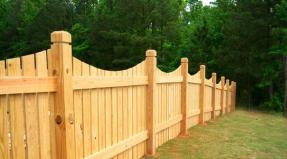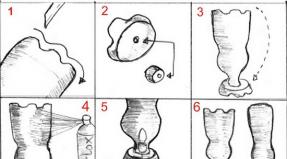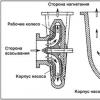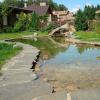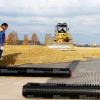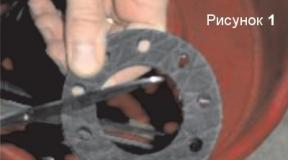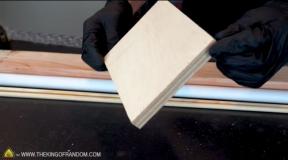Geogrid or reinforcement of slopes and ravines
Volumetric geogrid allows you to strengthen the slopes and ravines
In this article we will talk about such an indispensable material in landscape construction as a geogrid. Sometimes it is impossible to do without it at the most important - the initial stage of construction. Obviously, before starting construction, every nuance, every detail and every detail should be thought out so that the foundation of the house comes out sound, and the building has served not for a year or two, but from generation to generation.
The use of geogrids in the construction of retaining walls
Meet the geogrid
What exactly is a geogrid? This is a cell structure made of a polymer material that is resistant to environmental influences. Thanks to the use of polymers, neither moisture, nor acids, nor alkalis, nor even microorganisms, and even more so ultraviolet and wind, are not capable of causing any visible harm to the geogrid. In more detail, a geogrid is obtained from polyethylene tapes synthesized by extrusion (due to its use, the molecules are oriented in space), then they are joined in a checkerboard pattern by ultrasonic welding. Such a tape has a tensile strength of 11-14 kN / m, and the weld will withstand a load of at least 7 kN / m, and the thicker the web, the greater these indicators.
The geogrid is laid on top of the geotextile, after which the geogrid is fixed with anchors
The use of geogrids in construction
Earthen slopes are strengthened with a geogrid in order to prevent shedding, and in the future, the formation of landslides and screes. Loose and heterogeneous soil is especially susceptible to this process. The geogrid effectively resists the erosion of banks and slopes near water bodies, regardless of whether it is a river, a reservoir or a decorative pond. For use in water structures, a volumetric geogrid is placed directly on the bottom of the proposed reservoir.
Garden paths, artificial embankments, terraces and driveways, as well as landscaping areas, campsites, parking lots and areas around sports facilities are no longer complete without geogrids. In general, earth-covered areas that must withstand loads for a long time are reinforced with a geogrid, otherwise the soil quickly settles with the formation of pits and other undesirable changes.
Since 2003, the geogrid has been certified and produced according to technical specifications (TU). True, each manufacturer may have their own. But, nevertheless, all the necessary tests were successfully passed, as a result of which the geogrid began to be actively used not only in the construction of roads and strengthening various slopes, but also in other areas, for example, in landscape design and strengthening slopes during the construction of retaining walls.
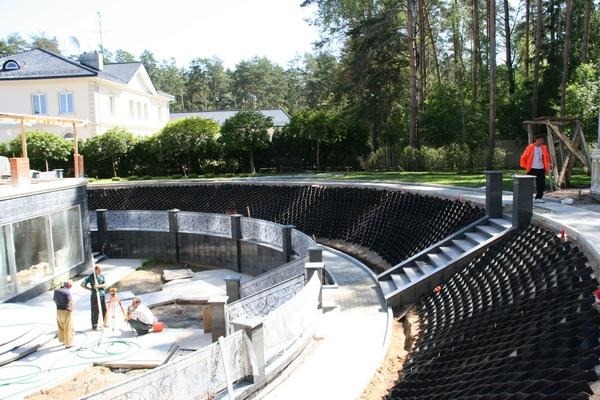
How modern eco-parkings or a lawn grid are built
A more durable version of the geogrid - a lawn grid, is the main component for creating such a structure as an eco-parking or eco-parking. Ecological parking, equipped on the site, looks modern and beautiful. Outwardly, it is a neat lawn. At the heart of such a grass flooring is a three-dimensional geogrid or lawn grid, and vegetable soil is used as a fixative. The grass that has grown through the grate is constantly "cut" by parked cars, and the same level of grass growth is obtained.
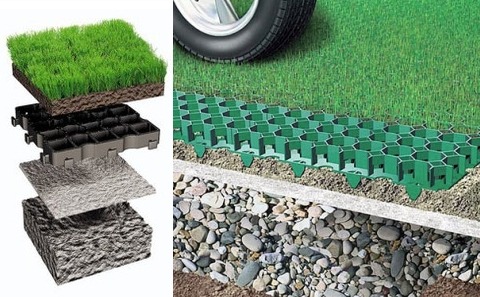
Lawn grate - the main element of eco-parking
So, protecting the soil and vegetation on it from loads, the lawn grate simultaneously allows water to enter the ground and prevents the formation of failures, because it easily withstands the weight of an average car. Thus, the use of a lawn grill gives your parking lot:
- reliability - due to high bearing capacity;
- the natural beauty of a thick grassy carpet;
- ease of maintenance.
Another positive aspect of the use of geogrids is the lack of toxicity of the material, which retains its integrity during many years of operation. In fact, it creates a protected soil ecosystem with its own system of moisture circulation and nutrient exchange, and it requires minimal maintenance - just water the lawn to wash dust and dirt from the grass and give it a clean and aesthetic look.
To use a geogrid in an eco-parking structure, embossing and perforation are usually performed to increase the friction force of the web with the filler.
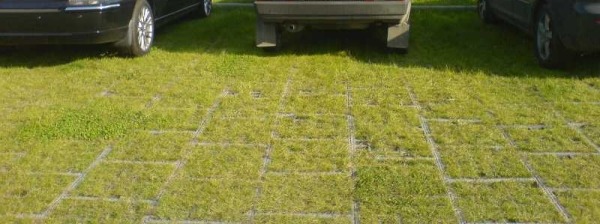
Laying a lawn grate during the construction of an eco-parking lot
1. First you need to remove the top loose layer of the earth. Although it is fertile, it contains organic plant remains (mostly grass and roots). In small areas, the soil layer is cut by hand. With a large area of the site, as a rule, they resort to the help of a bulldozer.
2. Now clean and level ground needs to be compacted with sand. A layer of 3-5 cm is compacted manually, with a vibrating roller or a vibrating plate - again, depending on the size of the site.
3. The lawn grate, unfortunately, does not just fix itself. For this, plastic, wooden or metal anchors with a length of 200-500 mm are used. In a set, they usually sell from 100 to 250 pieces with a diameter of 10 mm. Only thanks to these pins and pegs you can get the correct fixation of the modules. Its installation is carried out in stages, using the same anchors several times, since after filling with a fixative they can be removed. If you would like a more secure design, leave 2-3 L-shaped pins inside the module. To secure a section of 20 by 30 cells, you will need 20-25 anchors.
4. We also cannot do without laying geoxtile, which is needed to separate the main soil and our fixative, as well as to prevent weeds from sprouting and additional reinforcement of the top layer of the site. Typically, geotextiles are used with a density of 100 to 200 g/m.
5. Fix the geogrid with anchors at a distance of 12 cm from each other in width, and 10 cm in length. You also need to install anchors on all extreme cells of the module. 6. The modules are connected using a pneumatic stapler or a screwdriver - self-tapping screws with a press washer. Remove every fourth mounting anchor in width and every fifth in length, replacing it with an L-shaped anchor pressing the geogrid to the base of the site.
7. Fill the geogrid cells with soil to the height of the tape, remove the remaining mounting anchors. It is watered with water so that the soil shrinks, and then the grass seeds are already scattered. On top of them, you need to add soil again, also along the height of the cell. Watering the finished lawn is done every day until germination, and 2-3 times a week after. It is also possible to avoid problems with living vegetation and lay the finished decorative coating. To do this, crushed stone, gravel, sand and other mixtures with a fraction of at least 5 and not more than 20 mm are used as a fixative.
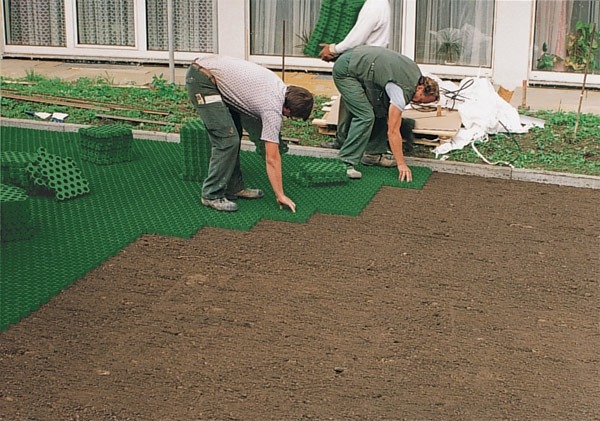
The geogrid is a close relative of the geogrid
A common type of volumetric geogrid is a flat geogrid, the main difference of which is the rectangular shape of the cells and the height of the canvas.
The geogrid is a flat, biaxially oriented propylene structure, which is also produced using the extrusion (extrusion) method. Due to the structure changed in comparison with the volumetric geogrid, the geogrid can be most effectively used in road construction. The principle of its operation is based on the introduction of a grid into a road “pie” between sand and crushed stone - crushed stone cannot penetrate through the cells and go deep into the sand, which, with high-quality tamping, causes stones to simply wedge over the entire surface of the geogrid. Thus, both horizontal and vertical movements of crushed stone are excluded, which increases the strength of the road structure. The dimensions of the geogrid cells differ significantly from the geogrid: 35 by 40, 33 by 33 and 40 by 40 mm. Such small holes are created for various fractions of crushed stone.
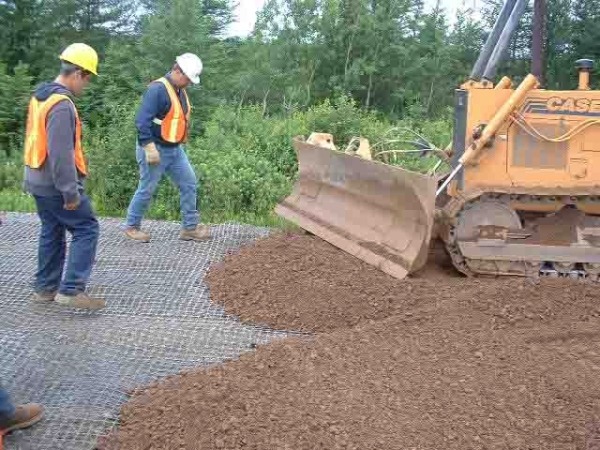
The use of geogrids in the construction of access roads
The use of a geogrid will allow:
- reduce the thickness of the crushed stone layer by about 40%, thereby reducing the cost of materials;
- distribute serious loads evenly over the coverage area;
- increase the time between repairs, because the structure will become much stronger;
- extend the performance of the coating by almost 3 times;
High-quality construction of roads, parking lots, entrances to houses, small paths and sites is not complete without a geogrid. When building a solid house, a real owner will spare no expense for an invisible foundation that will extend the life of coatings for decades.
Construction of an access road to the site
The problem of access to the house from a common road is a fairly common subject of discussion among those who have just acquired their site and are starting to develop it. It is not always possible to lay a deck just like that because of the gutter that runs along the exit, and besides, the road embankment is unlikely to be durable. The geogrid helps to solve this problem effectively.
The ditch is covered with a sand cushion, on which a pipe is laid, and after that the entire entrance area is covered with sand and carefully compacted. The geogrid is spread on compacted sand, and a layer of crushed stone about 10 cm thick is already laid on it. Following the principle described above, the cells do not let crushed stone deep into the sand, as a result of which the strength of the base increases. All this is once again compacted with a vibrating plate or a vibrating roller, and the congress already organized in this way will stand for quite a long time. And in order to perpetuate the structure, the exit is poured with concrete or rolled up with asphalt, and then it becomes invulnerable even to decades of constant use.

